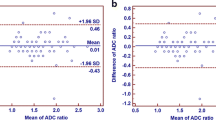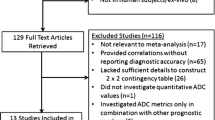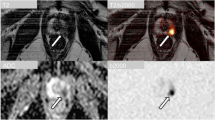Abstract
Objectives
To evaluate the influence of the choice of b values on the diagnostic value of the apparent diffusion coefficient (ADC) for detection and grading of prostate cancer (PCa).
Methods
Forty-one patients with biopsy-proven PCa underwent endorectal 3-T MRI before prostatectomy. Different combinations of b values (0–800 s/mm2) were used to calculate four representative ADC maps. Mean ADCs of tumours and non-malignant tissue were determined. Tumour appearance on different ADC maps was rated by three radiologists as good, fair or poor by assigning a visual score (VS) of 2, 1 or 0, respectively. Differences in the ADC values with the choice of b values were analysed using one-way ANOVA.
Results
Choice of b values had a highly (P < 0.001) significant influence on the absolute ADC in each tissue. Maps using b = [50, 800] and [0, 800] were rated best (VS = 1.6 ± 0.3) and second best (1.1 ± 0.3, P < 0.001), respectively. For low-grade carcinomas (Gleason score ≤ 6, 13/41 patients), only the former choice received scores better than fair (VS = 1.4 ± 0.3). Mean tumour ADCs showed significant negative correlation (Spearman’s ρ −0.38 to −0.46, P < 0.05) with Gleason score.
Conclusions
Absolute ADC values strongly depend on the choice of b values and therefore should be used with caution for diagnostic purposes. A minimum b value greater than zero is recommended for ADC calculation to improve the visual assessment of PCa in ADC maps.
Key Points
• Absolute ADC values are highly dependent on the choice of b values.
• Absolute ADC thresholds should be used carefully to predict tumour aggressiveness.
• Subjective ratings of ADC maps involving b = 0 s/mm 2 are poor to fair.
• Minimum b value greater than 0 s/mm 2 is recommended for ADC calculation.






Similar content being viewed by others
Abbreviations
- CG:
-
central gland
- CSI:
-
chemical shift imaging
- GS:
-
Gleason score
- PCa:
-
prostate cancer
- PZ:
-
peripheral zone
- VS:
-
visual score
References
Dickinson L, Ahmed HU, Allen C et al (2011) Magnetic resonance imaging for the detection, localisation, and characterisation of prostate cancer: recommendations from a European consensus meeting. Eur Urol 59:477–494
Schlemmer H-P (2010) Multiparametric MRI of the prostate: method for early detection of prostate cancer? Rofo 182:1067–1075
Gibbs P, Tozer DJ, Liney GP, Turnbull LW (2001) Comparison of quantitative T2 mapping and diffusion-weighted imaging in the normal and pathologic prostate. Magn Reson Med 46:1054–1058
Turkbey B, Shah VP, Pang Y et al (2011) Is apparent diffusion coefficient associated with clinical risk scores for prostate cancers that are visible on 3-T MR images? Radiology 258:488–495
Hambrock T, Somford DM, Huisman HJ et al (2011) Relationship between apparent diffusion coefficients at 3.0-T MR imaging and gleason grade in peripheral zone prostate cancer. Radiology 259:453–461
Kim CK, Park BK, Lee HM, Kwon GY (2007) Value of diffusion-weighted imaging for the prediction of prostate cancer location at 3-T using a phased-array coil: preliminary results. Invest Radiol 42:842–847
Tanimoto A, Nakashima J, Kohno H, Shinmoto H, Kuribayashi S (2007) Prostate cancer screening: the clinical value of diffusion-weighted imaging and dynamic MR imaging in combination with T2-weighted imaging. J Magn Reson Imaging 25:146–152
Haider MA, van der Kwast TH et al (2007) Combined T2-weighted and diffusion-weighted MRI for localization of prostate cancer. AJR Am J Roentgenol 189:323–328
Tamada T, Sone T, Jo Y et al (2008) Apparent diffusion coefficient values in peripheral and transition zones of the prostate: comparison between normal and malignant prostatic tissues and correlation with histologic grade. J Magn Reson Imaging 28:720–726
Gibbs P, Pickles MD, Turnbull LW (2006) Diffusion imaging of the prostate at 3.0 Tesla. Invest Radiol 41:185–188
Lim HK, Kim JK, Kim KA, Cho K-S (2009) Prostate cancer: apparent diffusion coefficient map with T2-weighted images for detection – a multireader study. Radiology 250:145–151
Riches SF, Hawtin K, Charles-Edwards EM, de Souza NM (2009) Diffusion-weighted imaging of the prostate and rectal wall: comparison of biexponential and monoexponential modelled diffusion and associated perfusion coefficients. NMR Biomed 22:318–325
Shinmoto H, Oshio K, Tanimoto A et al (2009) Biexponential apparent diffusion coefficients in prostate cancer. Magn Reson Imaging 27:355–359
Kitajima K, Kaji Y, Kuroda K, Sugimura K (2008) High b-value diffusion-weighted imaging in normal and malignant peripheral zone tissue of the prostate: effect of signal-to-noise ratio. Magn Reson Med Sci 7:93–99
Kim CK, Park BK, Kim B (2010) High-b-value diffusion-weighted imaging at 3-T to detect prostate cancer: comparisons between b values of 1,000 and 2,000 s/mm2. AJR Am J Roentgenol 194:W33–37
Verma S, Rajesh A, Fütterer JJ et al (2010) Prostate MRI and 3D MR spectroscopy: how we do it. AJR Am J Roentgenol 194:1414–1426
D’Amico AV, Moul J, Carroll PR, Sun L, Lubeck D, Chen M-H (2003) Cancer-specific mortality after surgery or radiation for patients with clinically localized prostate cancer managed during the prostate-specific antigen era. J Clin Oncol 21:2163–2172
Le Bihan D, Breton E, Lallemand D, Aubin ML, Vignaud J, Laval-Jeantet M (1988) Separation of diffusion and perfusion in intravoxel incoherent motion MR imaging. Radiology 168:497–505
DeLano MC, Cooper TG, Siebert JE, Potchen MJ, Kuppusamy K (2000) High-b-value diffusion-weighted MR imaging of adult brain: image contrast and apparent diffusion coefficient map features. AJNR Am J Neuroradiol 21:1830–1836
Gleason DF (1992) Histologic grading of prostate cancer: a perspective. Hum Pathol 23:273–279
Uhl M, Altehoefer C, Kontny U, Il'yasov K, Büchert M, Langer M (2002) MRI-diffusion imaging of neuroblastomas: first results and correlation to histology. Eur Radiol 12:2335–2338
Vargas HA, Akin O, Franiel T et al (2011) Diffusion-weighted endorectal MR imaging at 3-T for prostate cancer: tumor detection and assessment of aggressiveness. Radiology 259:775–784
Maier SE, Tang Y, Panych LP, Mulkern RV, Tempany CM (2011) Non-monoexponential diffusion signal decay in prostate cancer. Proc. of 19th ISMRM Annual Meeting and Exhibition, Montreal
Hom JJ, Coakley FV, Simko JP et al (2006) Prostate cancer: endorectal MR imaging and MR spectroscopic imaging – distinction of true-positive results from chance-detected lesions. Radiology 238:192–199
Vilanova JC, Comet J, Barceló-Vidal C et al (2009) Peripheral zone prostate cancer in patients with elevated PSA levels and low free-to-total PSA ratio: detection with MR imaging and MR spectroscopy. Radiology 253:135–143
Kim JH, Kim JK, Park B-W, Kim N, Cho K-S (2008) Apparent diffusion coefficient: prostate cancer versus noncancerous tissue according to anatomical region. J Magn Reson Imaging 28:1173–1179
Mazaheri Y, Hricak H, Fine SW et al (2009) Prostate tumor volume measurement with combined T2-weighted imaging and diffusion-weighted MR: correlation with pathologic tumor volume. Radiology 252:449–457
Park SY, Kim CK, Park BK, Lee HM, Lee KS (2011) Prediction of biochemical recurrence following radical prostatectomy in men with prostate cancer by diffusion-weighted magnetic resonance imaging: initial results. Eur Radiol 21:1111–1118
Acknowledgement
Grant support from the German Federal Ministry of Education and Research under BMBF 13N10360 is gratefully acknowledged.
Author information
Authors and Affiliations
Corresponding author
Rights and permissions
About this article
Cite this article
Thörmer, G., Otto, J., Reiss-Zimmermann, M. et al. Diagnostic value of ADC in patients with prostate cancer: influence of the choice of b values. Eur Radiol 22, 1820–1828 (2012). https://doi.org/10.1007/s00330-012-2432-3
Received:
Revised:
Accepted:
Published:
Issue Date:
DOI: https://doi.org/10.1007/s00330-012-2432-3




